I was as surprised as anyone when Wizards of the Coast decided to release reprints of their old editions. It is a smart move, and one I’m glad to see them make, but personally the really interesting thing was the deluxe reprints of their Advanced Dungeons and Dragons First Edition books. Nice paper, thick covers, ribbon bookmarks, the works. I’ve heard people complain that the shading is too dark, but to me it looks crisp, and captures some of the fainter lines that might otherwise be overlooked. The fact that they donate a portion of the profits to the Gary Gygax Memorial Fund is more than icing on the cake; it is credit where credit is due (though it would be nice to have a Dave Arneson memorial, too; maybe if they reprint the non-advanced D&D?). I decided the best thing to do with these books is to look at them both in historical context…and in comparison to what follows. So I re-read them with a critical eye and was happy to find that they have a lot of great things to recommend them, and plenty of opportunities to talk about the evolution of game design.
I’m kind of amazed that my complaints about this Player’s Handbook are exactly the same as the complaints I’d make about almost any edition’s handbook…except, interestingly, 4e. Spells, for instance. Just from a pure layout perspective, a raw data point of view…spells take up half the dang book. Let’s literally count it out; 127 pages, 57 of them are spells. In 3.5e spells are 122 out of 317 pages, so we’re still in the same ballpark. The fact that a significant chunk of those spells don’t overlap—that is, they are priest or wizard exclusive—just exacerbates the problem. I like the Vancian magic system—in its place, I’m not saying it is the only system I like—but I’ve always found it wonky that so much of the book is given over to spellcasters, exclusively.
Personally, I’d advocate for one generic listI loathe class specific lists, like “paladin” or “bard” spells—but I would also like to see some way of making them relevant to other classes. Maybe through items? This, I think, is the train of logic that led to the paradigm of 4e, starting with the Tome of Battle: Book of Nine Swords. There should be fun toys for fighters and thieves, too! I don’t think 4e’s solution was the right one (personally), but I understand the impulse. The other option of making every weapon have its own power, or a list of “Maneuvers,” that are sort of martial spells, I get that too. I suppose this is where Feats came from, and let me tell you, I really like idea of Feats. I am sad they became “+2 to intimidate, +2 to saves versus petrification, if you have your back to a wall, if you are a grey elf fighter who specializes in spears.”
Which is one place where AD&D First Edition soars. It doesn’t over-specify, and it doesn’t over-restrict. Take wish for example. Third Edition has a laundry list of qualifications (duplicate an 8th level wizard spell, or a 6th level spell that isn’t a wizard spell, or a 7th level wizard spell from a prohibited school, or…) before finally putting at the end, as if in small print, that they could wish for whatever they want, and the DM could adjudicate it. It takes up about half the page. AD&D is about a paragraph; it gives examples, consequences and then invokes the Dungeon Master. This is a huge difference in tone; Third Edition is narrow, balanced and explicated; First Edition spells and powers may vary widely in usefulness and power, but they are broad in scope. That is the whole point of having a Dungeon Master, after all: you have an impartial referee! Use that.
opens in a new window The Monster Manual of Advanced Dungeons and Dragons First Edition is a revelation. I like critter collections; I’ve talked before about Pathfinder’s Bestiaries, and why, but it boils down to the fact that…well, they’re cool! Even if you don’t play the game, you can still flip through it and think chimeras and hook horrors and mindflayers are awesome. Which follows through; even if you aren’t going to use any given monster, you can still find them interesting, and who knows, maybe flipping through you’ll find something that inspires you. I’ve built entire adventures, campaign tent poles, around a monster that tickled my fancy. I have one big pet peeve about monster stat blocks, though; I hate it when they are, essentially, a pile of hit points and a damage die. That…isn’t helpful to me. Boring. There are a few offenders here, but by and large I was very impressed with how closely the 1e Monster Manual adhered to my monster design philosophy: make every monster a mini-game.
The Monster Manual of Advanced Dungeons and Dragons First Edition is a revelation. I like critter collections; I’ve talked before about Pathfinder’s Bestiaries, and why, but it boils down to the fact that…well, they’re cool! Even if you don’t play the game, you can still flip through it and think chimeras and hook horrors and mindflayers are awesome. Which follows through; even if you aren’t going to use any given monster, you can still find them interesting, and who knows, maybe flipping through you’ll find something that inspires you. I’ve built entire adventures, campaign tent poles, around a monster that tickled my fancy. I have one big pet peeve about monster stat blocks, though; I hate it when they are, essentially, a pile of hit points and a damage die. That…isn’t helpful to me. Boring. There are a few offenders here, but by and large I was very impressed with how closely the 1e Monster Manual adhered to my monster design philosophy: make every monster a mini-game.
When I read a creature entry, I scan down to the “special” section where unique powers and abilities are located. This book is ripe with them. Did you know about Demons’ Amulets and Devil’s Talismans? Just little story devices that allow you to use fiends as more than just “a thing to fight.” Heck, this book has rules for how to subdue a dragon, rather than slay it! Little ad hoc mechanical cul de sacs; they don’t need to be used for everything, in every situation, but they add options. If the adage “when all you have is a hammer, everything looks like a nail” hold true—which, in true D&D hack-n-slash fashion would be, kill everything and loot the corpses—it is nice to see entries saying “how about a screwdriver, how about a fork, how about a whistle?”
opens in a new window I’ve rarely been impressed by a Dungeon Masters Guide. What is it, exactly? A collection of essays, of esoteric rules, random tables and then magic items? Just not my thing. In the First Edition DMG, I was happy to see it start off with a discussion of statistics! Not “Strength” or “Intelligence” but in the distribution curve of 3d6 compared to the flat randomness of a d20. Sadly, it was only a page, but more of this, please! Math matters to the game; it is hard to know how a given tweak will twist actual play, and a little guidance would be much appreciated, since this is the thing I imagine many people have the hardest time with. I can flip through the Monster Manual and decide “oh, an otyugh in the sewers, that would be a fun random urban encounter” so save the random table; what I need is someone who will explain the ramifications of a +2 to an attribute versus a +2 to hit versus a +2 to damage versus an upgrade from a d4 to a d6.
I’ve rarely been impressed by a Dungeon Masters Guide. What is it, exactly? A collection of essays, of esoteric rules, random tables and then magic items? Just not my thing. In the First Edition DMG, I was happy to see it start off with a discussion of statistics! Not “Strength” or “Intelligence” but in the distribution curve of 3d6 compared to the flat randomness of a d20. Sadly, it was only a page, but more of this, please! Math matters to the game; it is hard to know how a given tweak will twist actual play, and a little guidance would be much appreciated, since this is the thing I imagine many people have the hardest time with. I can flip through the Monster Manual and decide “oh, an otyugh in the sewers, that would be a fun random urban encounter” so save the random table; what I need is someone who will explain the ramifications of a +2 to an attribute versus a +2 to hit versus a +2 to damage versus an upgrade from a d4 to a d6.
The rest of the Dungeon Masters Guide is as you’d expect: charts on how many rangers make up a band of rangers, or how fast a boat goes, or how hard types of stone are. Not organized as well as later editions; that is something where the game unequivocally improved. Really though, I imagine people use the DMG the same way I do; they flip to the back where the magic items are. Lo! Here they are, and just like with monsters and with spells, we’re in for a treat. In the search for efficiency and balance, later editions reduced magic items to…well, video game upgrades. Get equipped with…+3 flaming broadsword! Heck, later editions expect that you’ll have “appropriate” magic weapons and magic armor as you increase. That doesn’t sound magical at all. At least in Skyrim you get to make the stuff yourself! None of that here. Items are magical, not to mention frequently unsafe. Curses ahoy, Gygax you jerk!
The items, frankly, are neat as all get out. There is a good reason that all of the items here have been re-imagined in every subsequent edition—they are fantastic. Some of them are stupidly designed—really cloak of elvenkind, you need to differentiate between a 99% chance to hide in “outdoors, light growth” and a 95% chance in “outdoors, rocky terrain”?—but most of the items are gloriously, wondrously open-ended. As with spells, one of the reasons you have a Dungeon Master is so that he can reward Player ingenuity while at the same time reigning in abuses of mechanics. The section on artifacts is…a mixed bag. First off, the Hand of Vecna! We all agree that the Hand and Eye of Vecna are the best artifacts, right? At least, major artifacts; the best minor artifact is the sphere of annihilation. Okay, the Mighty Servent of Leuk-O is pretty great; who doesn’t like mecha? Like the apparatus of kwalish’s bigger sibling. While the backstories are wonderful, and I appreciate the impulse to leave artifacts open for DMs to tweak…a blank list of powers is just not helpful. Which is what you get, literal blank lines printed in the book. Come on, at least give a default suggestion!
Mordicai Knode was going to say he is Switzerland in the Edition Wars, but extending that metaphor leads to a Godwin in either direction, so never mind. You can find him on Tumblr and Twitter.










